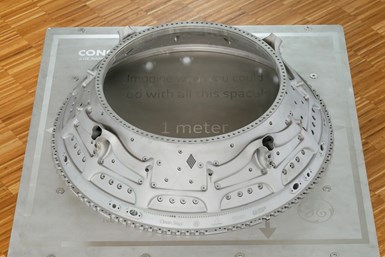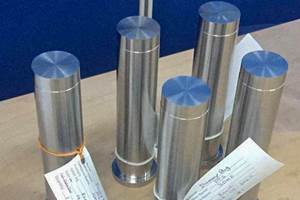GE Additive Helps Build Large Metal 3D Printed Aerospace Part
The research is part of an initiative to develop more fuel-efficient air transport technologies as well as a strong, globally competitive aeronautical industry supply chain in Europe.
Share
Read Next
The one-meter-in-diameter part was additively manufactured in nickel alloy 718 on a GE Additive system using the direct metal laser melting (DMLM) process. Photo Credit: GE Additive
GE Additive is working to develop larger, lighter additive parts. It’s part of the GE Aerospace Advanced Technology Munich-led European consortium which created one of the largest ever metal 3D-printed aerospace parts — a part that also demonstrates significant cost, weight and time savings.
The EU’s European Green Deal sets out to reduce transport emissions by 90% by 2050 (compared to 1990 levels) with the aviation sector playing its part. Priorities going forward include financial and regulatory measures to drive low-emissions aviation and the urgent development of clean sheet frames, new aircraft engines and propulsion systems, and sustainable aviation fuel.
One significant research initiative underway to develop these types of more fuel-efficient air transport technologies for the earliest possible deployment is the European Commission and European aerospace industry-funded Clean Sky 2 Programme, now entering its final phase. Its successor, Clean Aviation, was launched in December 2021.
The Clean Sky 2 program is made up of key industry players and subject matter experts along with academic research bodies across Europe. The program is integrating, demonstrating and validating technologies capable of reducing CO2 emissions as well as nitrous oxide (NOx) and noise emissions by up to 30% compared to 2014’s state-of-the-art aircraft. Another goal is to develop a strong and globally competitive aeronautical industry and supply chain in Europe.
Based in Munich, Germany, the GE Aerospace Advanced Technology (GE AAT) Munich team leads three core partnerships in the Clean Sky 2 program to identify engine hardware, benefits, design, manufacturing process and, connected to the program’s goals, collaborate closely with GE Aerospace’s sites in Italy, Czech Republic, Poland and Turkey, as well as external partners.
One of the GE AAT Munich-led partnerships is the Turbine Technology Project (TURN), which was set up to accelerate technology maturation for future aero engines. And, in response to a Clean Sky 2 call for proposals in 2018, a consortium of Hamburg University of Technology (TUHH), TU Dresden (TUD) and technology company Autodesk was selected to support GE AAT Munich for the design and manufacturing of a large-scale metal additive manufacturing component – the Advanced Additive Integrated Turbine Centre Frame (TCF) casing – the MONACO project. This also included the design and production of coupons and critical parts, validation and qualification, and the final delivery of the full-sized metal 3D printed casing.
After almost six years in R&D and engineering, the large-format TCF casing design using GE
Additive’s Direct Metal Laser Melting (DMLM) technology in nickel alloy 718 was recently unveiled by the consortium. The TCF casing is one of largest additively manufactured parts produced for the aerospace industry.
The additively manufactured TCF casing is designed for narrow-body engines in which the part is approximately one meter or more in diameter. Having this single-piece design solution to produce this kind of large format engine hardware with reduced cost, weight and manufacturing lead time gives a competitive business advantage.
“We wanted to reduce the weight of the part by 25%, but also improve the pressure losses of the secondary air flow as well as a strong reduction in part count to improve maintenance,” says Dr. Günter Wilfert, GE AAT Munich’s technology and operations manager.
The shift from conventional casting to AM reduced cost and weight by 30%. The consolidation combined more than 150 parts into one and lead time was reduced from more than nine months down to only two-and-a-half months.
The team can be proud of the results. “Those targets were achieved and surpassed. We were able to reduce the weight by ~30% in the end. The team also reduced the manufacturing lead time from nine months to two and a half months, by approximately 75%. Over 150 separate parts that make up a conventional turbine center frame casing have been consolidated into one single piece design,” Wilfert adds.
Outside of the environmental, performance, weight, cost benefits and reduction of waste material of this new part, perhaps the biggest impact will be supply chain disruption in all industries facing challenges with their casting in conventional manufacturing.
Due to stringent requirements on airworthy hardware in the highly regulated aerospace industry, the number of approved vendors for casting and forging parts is very limited. This creates long lead times and high costs. These challenges, and the fact that a turbine center frame isn’t a rotating part, made it an ideal candidate for additive manufacturing.
“Additive manufacturing offers enormous potential to lower weight, improve component functionalities, and substantially reduce part count in complex assemblies, directly increasing aircraft energy efficiency, and reducing assembly costs and time,” says Christina-Maria Margariti, project officer for hydrogen-powered aircraft for Clean Aviation.
“The Clean Aviation program, in line with the EU Green Deal objective of carbon neutrality by 2050, supports the launch of disruptive new products by 2035, with the aim to replace 75% of the operating fleet by 2050. Faster time to market and increased production rates will therefore be crucial to reaching these ambitious environmental targets,” Margariti adds.
- Read about the GE Additive collaboration with WSU-NAIR to accelerate the military’s metal additive technology implementation.
- Learn about the work of the U.S. Air Force and GE Additive in the Pacer Edge Program — a metal additive manufacturing (AM) pathfinder to showcase the application of AM in aerospace.
Related Content
Video: 5" Diameter Navy Artillery Rounds Made Through Robot Directed Energy Deposition (DED) Instead of Forging
Big Metal Additive conceives additive manufacturing production factory making hundreds of Navy projectile housings per day.
Read MoreThis Year I Have Seen a Lot of AM for the Military — What Is Going On?
Audience members have similar questions. What is the Department of Defense’s interest in making hardware via 3D printing over conventional methods? Here are three manufacturing concerns that are particular to the military.
Read MoreTwo 12-Laser AM Machines at Collins Aerospace: Here Is How They Are Being Used
With this additive manufacturing capacity, one room of the Collins Iowa facility performs the work previously requiring a supply chain. Production yield will nearly double, and lead times will be more than 80% shorter.
Read MoreConocoPhillips Sees Oil and Gas Supply Chain Opportunity With Additive Manufacturing
Production of parts when needed and where needed can respond to the oil and gas sector’s multibillion-dollar challenge of holding parts in inventory. The supply chain benefit will justify additive even before the design freedoms are explored.
Read MoreRead Next
Bike Manufacturer Uses Additive Manufacturing to Create Lighter, More Complex, Customized Parts
Titanium bike frame manufacturer Hanglun Technology mixes precision casting with 3D printing to create bikes that offer increased speed and reduced turbulence during long-distance rides, offering a smoother, faster and more efficient cycling experience.
Read MoreProfilometry-Based Indentation Plastometry (PIP) as an Alternative to Standard Tensile Testing
UK-based Plastometrex offers a benchtop testing device utilizing PIP to quickly and easily analyze the yield strength, tensile strength and uniform elongation of samples and even printed parts. The solution is particularly useful for additive manufacturing.
Read More3D Printed Polymer EOAT Increases Safety of Cobots
Contract manufacturer Anubis 3D applies polymer 3D printing processes to manufacture cobot tooling that is lightweight, smooth and safer for human interaction.
Read More





















